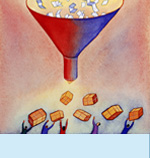


  |
||||
| PRINTER FRIENDLY VERSION
It's Time to Put on Your Cape and Be a Superhero "Consumer confidence sinks to record low," reads the headline in recent newspaper stories about our economic woes. Based on the emails I've been receiving from colleagues, consumers aren't the only ones with low confidence these days. Measurement professionals, too, feel adrift in a sea of uncertainty and pessimism. "With marketing budgets down, measurement budgets will get the axe." "Batten down the hatches, 'cause a hard rain's a-gonna fall." Step aside, naysayers. I couldn't agree less. The way I see it, measurement experts are uniquely qualified to help navigate their organizations and clients out of this mess. In fact, our services are needed now more than ever. Let's face it. In this kind of economic climate there's no room for wasted expenditures. Companies are much less likely to want to move ahead with major marketing expenditures or new product launches out of fear that they won't be successful and they'll have wasted their limited funds. Risk taking is definitely down. In that vein, there may be less of a need for evaluative measurement because of fewer new initiatives. However, out of this trepidation comes opportunity – the opportunity for research professionals to help organizations make smart decisions up-front about how to wisely spend their dollars (or euros or yen). Intelligent research conducted as part of program or product design can immunize employers and clients from the difficulties of the economy and increase the likelihood of their success from the start. In other words, effective research conducted as part of the planning process reduces the margin of error. And that's most definitely super-hero material. The Three Surprising Elements That Drive Customers to "Gotta Have It!" Take a look at your product and service offerings. Hopefully, you know them inside-out. You could describe them in your sleep and can rattle off their attributes on a moment's notice. But contrary to the traditional view of marketing, your perceptions and descriptions are not what are going to sell your products. Buying decisions aren't made based on what you think of your offerings. Buying decisions are made based on what your customers think. Getting upfront insight into your customers' perceptions and decision-making process will enable you to market offerings in a way that actually draws them to you. Following up on this idea of "putting it in reverse" and enticing buyers to come to you, let's talk specifically about how to identify "The Three Surprising Elements That Drive Customers to ‘Gotta Have It!'" Find the Tension You are probably familiar with the old sales advice to "find the pain" when preparing to approach a prospect. Taking that rudimentary approach to the next psychological level, I've noticed in 20 years of conducting market research that consumers often experience some kind of tension about products or services. While they need or want an experience, they struggle with some aspect of it that makes them reluctant to buy or detracts from their enjoyment. For instance, they're relieved to have time to themselves when their child watches a video but they feel like a bad parent because they've stuck their kid in front of the TV. If we can identify and understand this tension, we can then explore how our product or service can provide a solution. Following are examples of tension we've identified when consulting for various organizations:
Enable Positive Self-Talk Positive self-talk occurs when consumers feel better about themselves as a result of using a product or service. It's what people say or think to themselves when they get an emotional benefit from using a product. For instance, a company that produces a video that teaches children to speak a foreign language might elicit positive self-talk from a parent who, instead of feeling guilty about sticking her child in front of the TV when she needs a break, feels like a better parent because her daughter is learning to speak French. The following are insights into positive self-talk we have observed when conducting qualitative research for a range of clients:
Get it Straight from the Source's Mouth The third element that drives consumers to "Gotta Have It!" is to identify the most appealing language to use in product descriptions and marketing. There's only one way to get this right and that's to hear it directly from the consumer -- or as I like to call it -- "Straight from the Source's Mouth." When you get your marketing language straight from the source's mouth, you can be confident you will turn heads amongst your customers. For instance, FedEx's renowned "When it absolutely, positively has to be there overnight" was first uttered by a customer in a focus group. Can't you just see some variation of the following in ad campaigns for the products or services – either through actual copy or thematic content?
In summary, effective up-front research can save the day and enable products and marketing to actually attract customers. No matter what the current economic circumstances, research that predicts what customers will need, want and buy will always be in great demand. The bottom line: if you do this right, your employer and clients will be saying, "Gotta have it!" about you! Jenny Schade is president of JRS Consulting, Inc., a firm that helps organizations build leading brands and efficiently attract and motivate employees and customers. Subscribe to the free JRS newsletter on www.jrsconsulting.net/newsletter.html © JRS Consulting, Inc. 2010 |
 |
|||
© 2008 JRS Consulting, Inc.